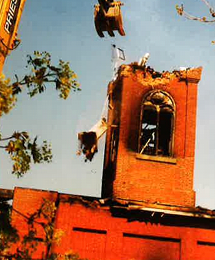
History
Cemetery History
Trinity Anglican Church Streetsville was founded in 1841 and the first interment was Ellen Roe (1815-1843). Canvassing the cemetery you will notice several children’s names on monuments and markers. Two of the youngest children resting in the cemetery are twins William and Henry Pallister, who died in 1848 at 16 days old.
The history of Trinity Cemetery is intertwined with the history of Streetsville. The names of people resting in Trinity Cemetery are bolded:
In 1805, Toronto Township (the area immediately west of Toronto) was formed when York (now the City of Toronto) purchased 84,000 acres from the Mississauga’s (First Nations people)
The first interment on this property was Ellen Roe (1815-1843)
In 1819, Timothy Street, a surveyor, noticed the potential for settlement by the Credit River.
James Glendinning was the first to settle on a piece of land on Mullet Creek. Timothy Street used stones from Glendinning’s land to build a saw and grist mill in 1821. Street’s red brick house built in 1825 at 41 Mill Street is one of the oldest brick houses in Peel Region.
John Barnhart, Sr. (1790-1863) built the Montreal House at the corner of Queen and Main Streets in 1821. The building still stands. John and his wife Olive (1792-1862) are interred in Trinity Cemetery
Trinity Anglican Church, Streetsville was founded in 1841 and opened for services in 1843. Both the land and bricks to build Trinity Church were provided by Henry Rutledge (1800-1875) another founding father of Streetsville, Rutledge was known as “the commodore”. He, his wife Ellen, and his 10 children are all resting at Trinity Cemetery.
Trinity Cemetery was formally established and consecrated by Reverend Robert Jackson McGeorge and congregation member James Hopkins (1795-1866) in 1842. It is reflective of an early Victorian style graveyard and provided a contemplative park space with walking paths to early residents.
In 1859 Streetsville was incorporated as a village and Timothy Street’s son John became the village’s first reeve.
Other figures of historical interest interred in the cemetery include:
3 militia men who fought in the War of 1812: John Barnhart (1863), James Davidson (1864) and William Birdsall (1877). Click Events for more information about these three men.
Robert Ramsay, (1813-1898), a wealthy farmer. An inquest found that he perished from neglect and malnutrition, and early instance of elder abuse. The Ramsay monument includes his wife Isabella (1823-1890) and 3 children, John (1858-1859), Joseph (1851-1854), and Hannah (1860-1860), all of whom predeceased Robert.
Edward Rutledge (1880-1959) former Chief of Police, Streetsville.
Timothy Street, Jr. (1825-1876), who died in a barn fire behind the Telegraph Hotel
Andrew Crozier (1859-1941) who authored a proposed anthem for the entire British empire in 1901.
Col. John Ham Perry (1892-1976) a veteran of World War I and II.
Elizabeth Pallister, (1819-1857), wife of John Pallister, and their six children, Eliza (1848-1848), twins William and Henry (1848-1848), John (1841-1849), Emily (1852-1854), and Mary (1854-1854)
Sam McCallion (1923-1997), first president of the Streetsville Bread & Honey Festival and co-founder, with his wife Hazel, of The Streetsville Booster.
Trinity Cemetery: An Early Victorian Graveyard
Trinity Church and cemetery opened in 1841, placing it at the very beginning of the Victorian Era. Many of Trinity's gravestones display common Victorian grave symbols such as a hand pointing up indicating the deceased’s ascent into heaven, lambs for those who where young and innocent, roses at different stages of blossoming for women, books for scholars, weeping willows symbolizing life after death, and wreaths symbolizing death and resurrection. Some of the stones also provide key insights to a person's life, such as a chisel for a mason, or a soldier with a cannon for a war veteran. All of these symbols can be found across the various Victorian gravestones across the cemetery.
Trinity Church Fire, 1998
On Saturday April 25th, the original Trinity Church was completely destroyed due to arson. The fire also caused changes to the cemetery. Cemetery records were lost and shifts in the earth moved graves that were close to the building's foundation. The church building was rebuilt and reopened in 2000. Now, the Cemetery Committee is determined to restore and upgrade the historic Trinity Cemetery, so that it may continue to serve generations of the past and future. If you would like to learn more about how to volunteer please visit GET INVOLVED, or to learn more about the cemetery join us for future EVENTS.










